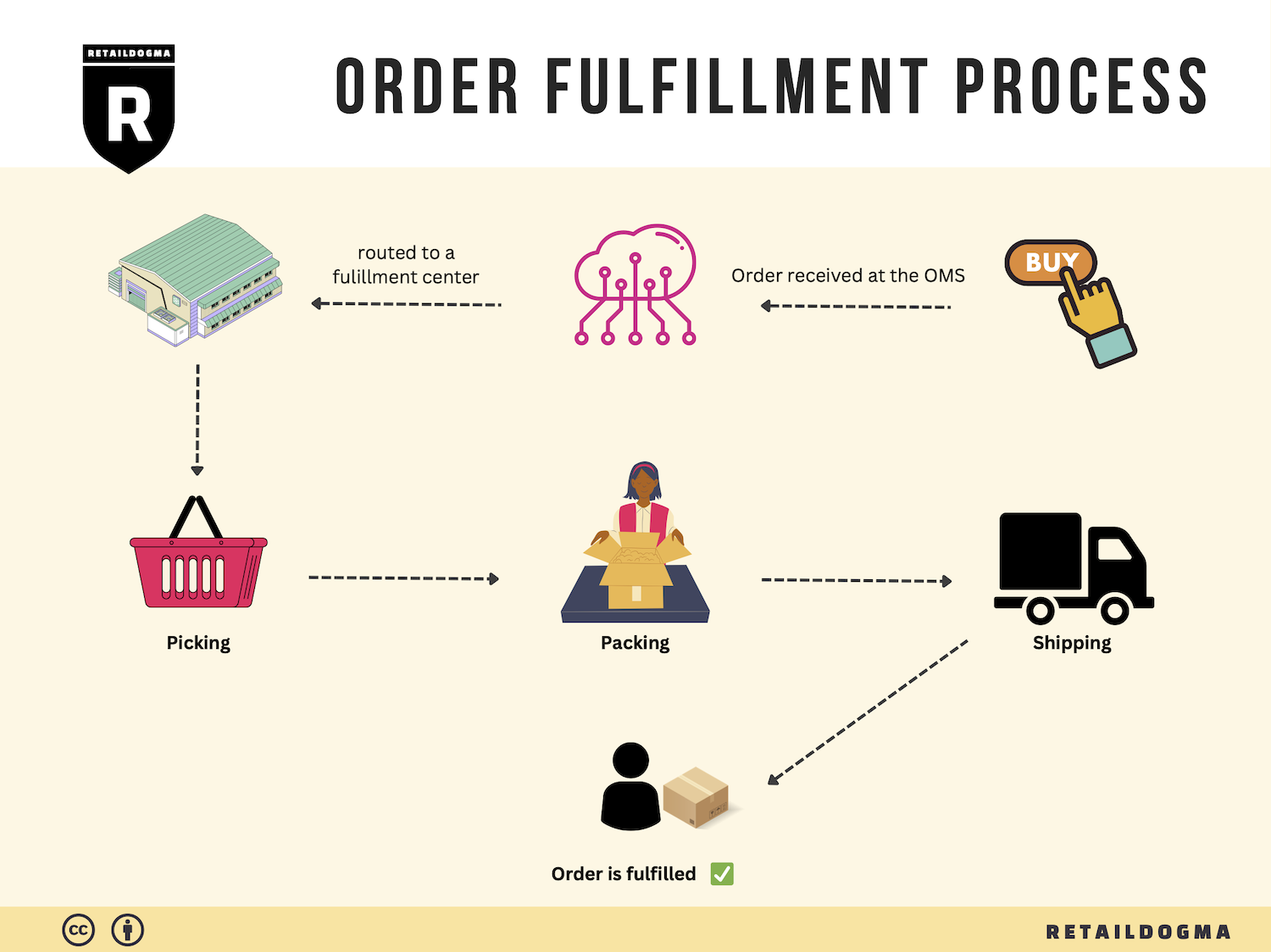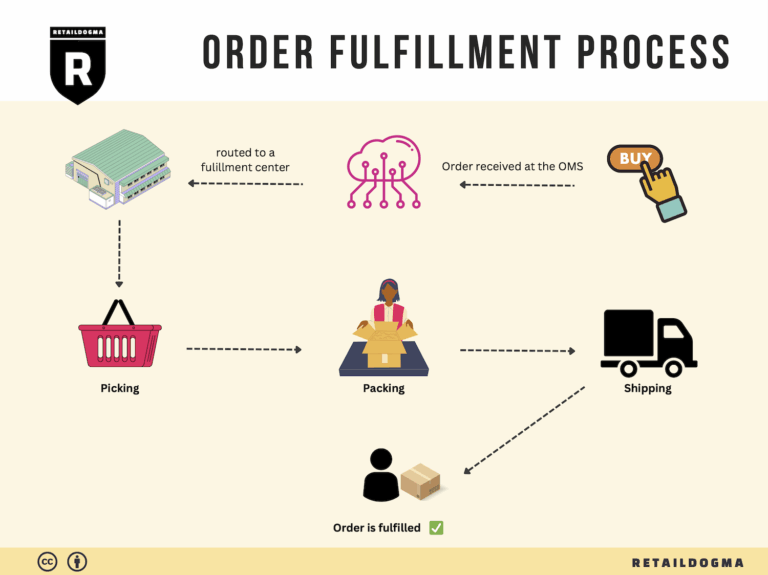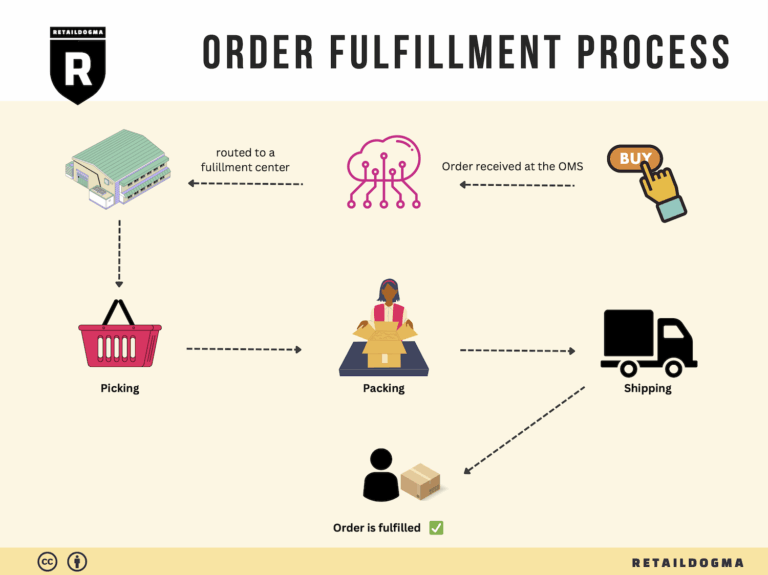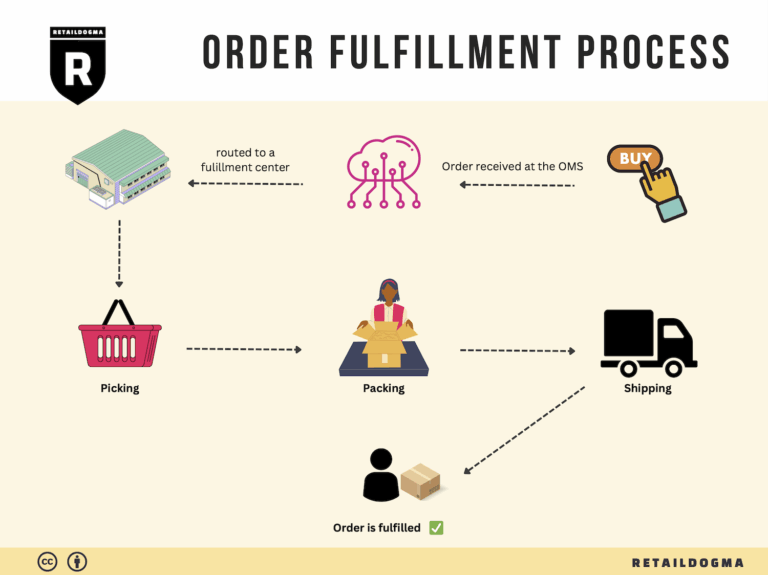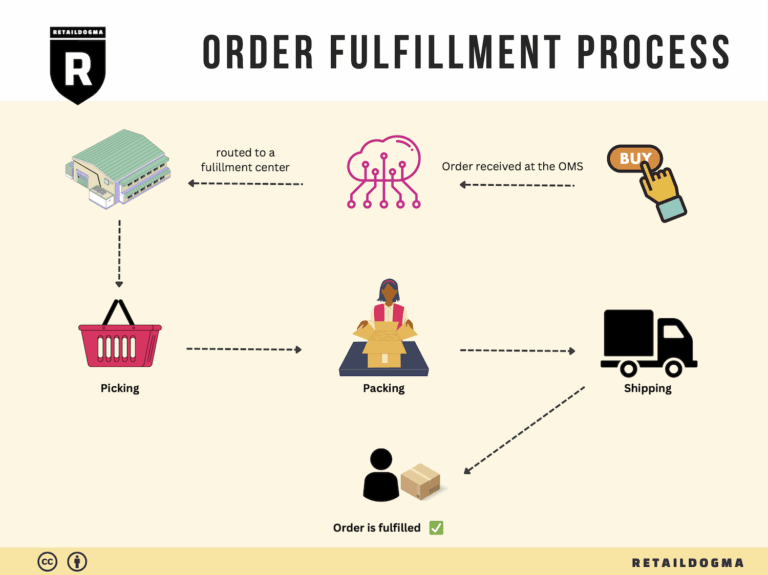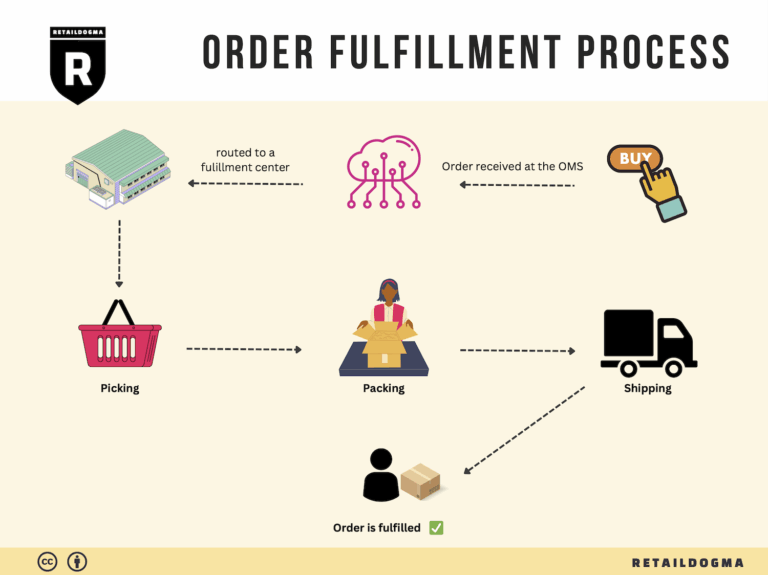What Is A Fulfillment Center? A Complete Guide (2025)
What is E-commerce Fulfillment? An Introduction for Growing Businesses
Understanding E-commerce Fulfillment: A Key to Scaling Your Business
As an e-commerce business owner, the excitement of growing sales can quickly turn into a daunting challenge when it comes to packing and shipping orders. Many entrepreneurs find themselves overwhelmed by the logistics of fulfillment, often struggling with the complexities of managing inventory, processing orders, and ensuring timely deliveries. The reality is that fulfillment is not just a backend operation; it is a crucial component of customer satisfaction and retention.
At its core, e-commerce fulfillment refers to the entire process of getting a product from your warehouse or fulfillment center to the hands of your customer. This process encompasses several key activities: receiving inventory, storing products, picking and packing orders, shipping, and handling returns. For growing businesses, optimizing fulfillment can mean the difference between a thriving operation and one that stumbles under the weight of its own growth.
This guide is designed to demystify the world of e-commerce fulfillment, providing you with practical insights to help you scale your logistics effectively. We will explore various fulfillment models, including third-party logistics (3PL) and Fulfillment by Amazon (FBA), highlighting the advantages and disadvantages of each approach. Understanding these models will enable you to choose the right strategy that aligns with your business goals and customer expectations.
Additionally, we will delve into the core services that fulfillment centers typically offer, such as inventory management, order processing, and shipping solutions. Knowing what to look for in a fulfillment partner is crucial; we will outline the key factors to consider when selecting a provider, including their technology capabilities, service levels, and scalability options.
Pricing is another vital aspect we will cover. Understanding the costs associated with fulfillment services can help you budget effectively and avoid unexpected expenses as your business grows. We’ll break down common pricing structures and what influences these costs, equipping you with the knowledge to negotiate better rates.
Ultimately, this guide aims to empower you to make informed decisions about your logistics strategy. By understanding the ins and outs of e-commerce fulfillment, you can streamline operations, enhance customer satisfaction, and position your business for sustainable growth. Whether you’re just starting or looking to optimize your existing processes, the insights provided here will be invaluable on your journey to success.
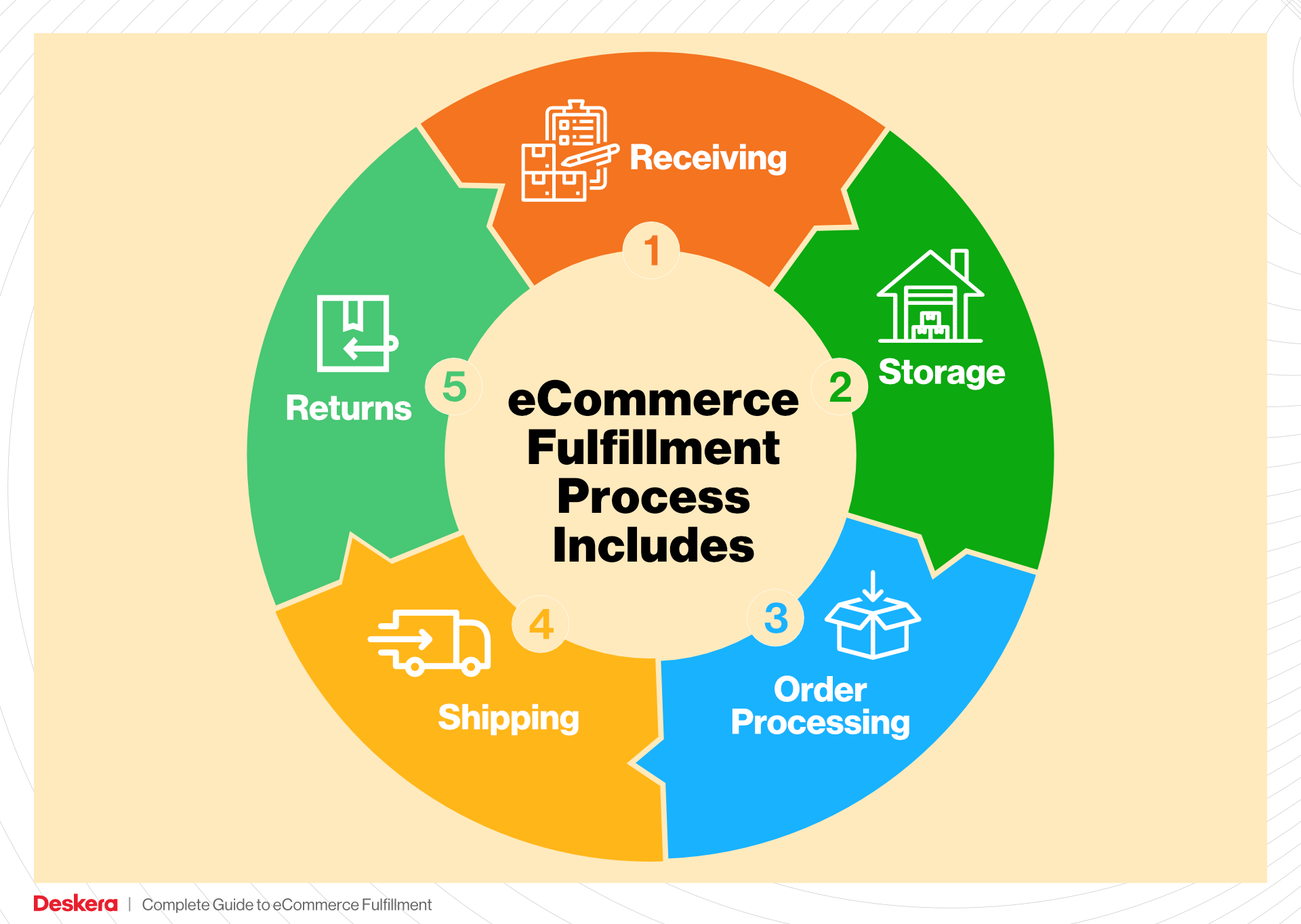
What You’ll Learn In This Guide
- What is E-commerce Fulfillment? An Introduction for Growing Businesses
- The Order Fulfillment Process: From ‘Buy’ Button to Customer’s Door
- Comparing Fulfillment Models: In-House vs. 3PL vs. Dropshipping
- A Deep Dive into Amazon FBA: Pros, Cons, and Who It’s For
- Core Services Offered by Fulfillment Centers
- How to Choose a Fulfillment Partner: A 6-Point Checklist
- Understanding Fulfillment Pricing: A Breakdown of Common Fees
- Frequently Asked Questions (FAQs) about Fulfillment
- Conclusion: Is Outsourcing Fulfillment the Right Move for Your Business?
- Important Disclaimer
The Order Fulfillment Process: From ‘Buy’ Button to Customer’s Door
1. Receiving Inventory
The order fulfillment process begins with receiving inventory at the fulfillment center. During this stage, products are delivered from suppliers or manufacturers and are checked for accuracy against purchase orders. Each item is scanned and recorded into the warehouse management system (WMS) using a unique identifier known as a SKU (Stock Keeping Unit). This ensures that inventory levels are accurately updated and discrepancies are minimized.
Receiving inventory is crucial as it sets the foundation for the entire fulfillment process. If items are not received accurately, it can lead to stockouts or overstock situations, both of which can negatively impact customer satisfaction and operational efficiency. The timely and accurate recording of inventory also helps in forecasting demand and managing supply chain operations effectively.
2. Warehouse Storage
Once inventory is received and logged, the next step is warehouse storage. This involves placing products in designated storage locations within the fulfillment center. The layout of the warehouse is designed to optimize space and facilitate easy access to items. Products are often categorized based on size, weight, or product type, and organized into zones to enhance picking efficiency.
Effective warehouse storage is essential for maximizing storage capacity and minimizing retrieval times. A well-organized warehouse allows for quicker order fulfillment, which is critical in today’s fast-paced e-commerce environment. Key terms associated with this step include ABC analysis, which classifies inventory based on value and turnover rates, helping businesses prioritize storage for high-demand items.
3. Order Picking
The order picking stage involves selecting items from their storage locations to fulfill customer orders. This is typically guided by pick lists, which detail the items and quantities needed for each order. Warehouse staff utilize various picking methods, such as single-order picking, batch picking, or zone picking, depending on the volume and nature of the orders.
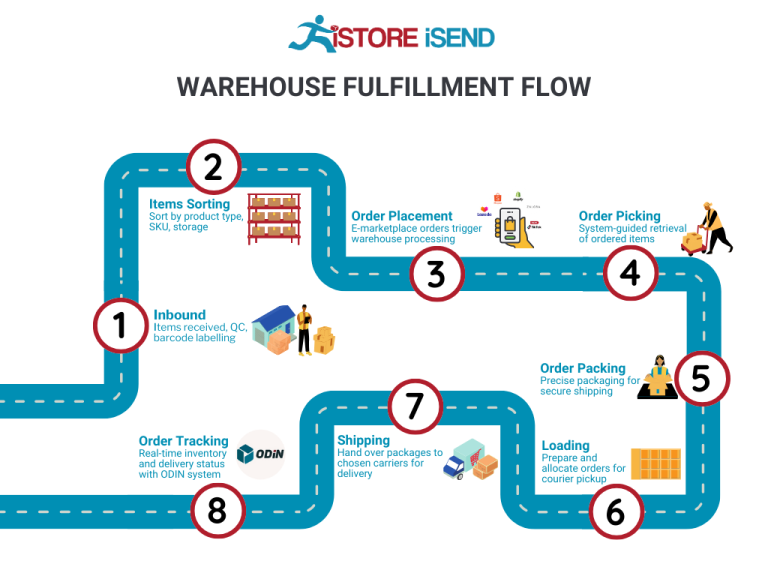
Order picking is a vital step in the fulfillment process because it directly impacts order accuracy and delivery speed. Errors in this stage can lead to customer dissatisfaction and increased return rates. Implementing technology, such as barcode scanners or RFID systems, can significantly improve picking accuracy and efficiency, reducing labor costs and increasing throughput.
4. Order Packing
After items have been picked, the next step is order packing. This involves securely packaging the items for shipment, ensuring that they are protected during transit. Packing stations are equipped with materials such as boxes, packing tape, and cushioning materials to safeguard products. Each order is labeled with shipping details, including the recipient’s address and tracking information.
Order packing is critical because it affects not only the condition of the products upon arrival but also the overall customer experience. Properly packed orders reduce the likelihood of damage during shipping and enhance the perception of the brand. A key term associated with this step is dimensional weight pricing, which is a method used by carriers to calculate shipping costs based on package dimensions rather than just weight, influencing how products are packed for cost efficiency.
5. Shipping & Delivery
The final step in the fulfillment process is shipping and delivery. Once orders are packed, they are handed off to shipping carriers who transport them to the customer’s address. Businesses often partner with multiple carriers to offer various shipping options, such as standard, expedited, and same-day delivery. Tracking systems allow customers to monitor their orders in real-time, providing transparency and enhancing customer satisfaction.
Shipping and delivery are paramount to e-commerce success, as they directly influence customer satisfaction and loyalty. Timely and reliable delivery can differentiate a brand in a competitive marketplace. The associated key term here is last-mile delivery, which refers to the final leg of the shipping process, where the package is delivered from a distribution center to the customer’s doorstep. Efficient last-mile delivery solutions can significantly reduce shipping costs and enhance the overall customer experience.
In conclusion, understanding each step of the order fulfillment process is essential for e-commerce business owners and operations managers aiming to scale their sales and logistics. By focusing on accuracy, efficiency, and customer satisfaction at each stage, businesses can create a seamless experience from the moment a customer clicks the ‘buy’ button to when their order arrives at their door.
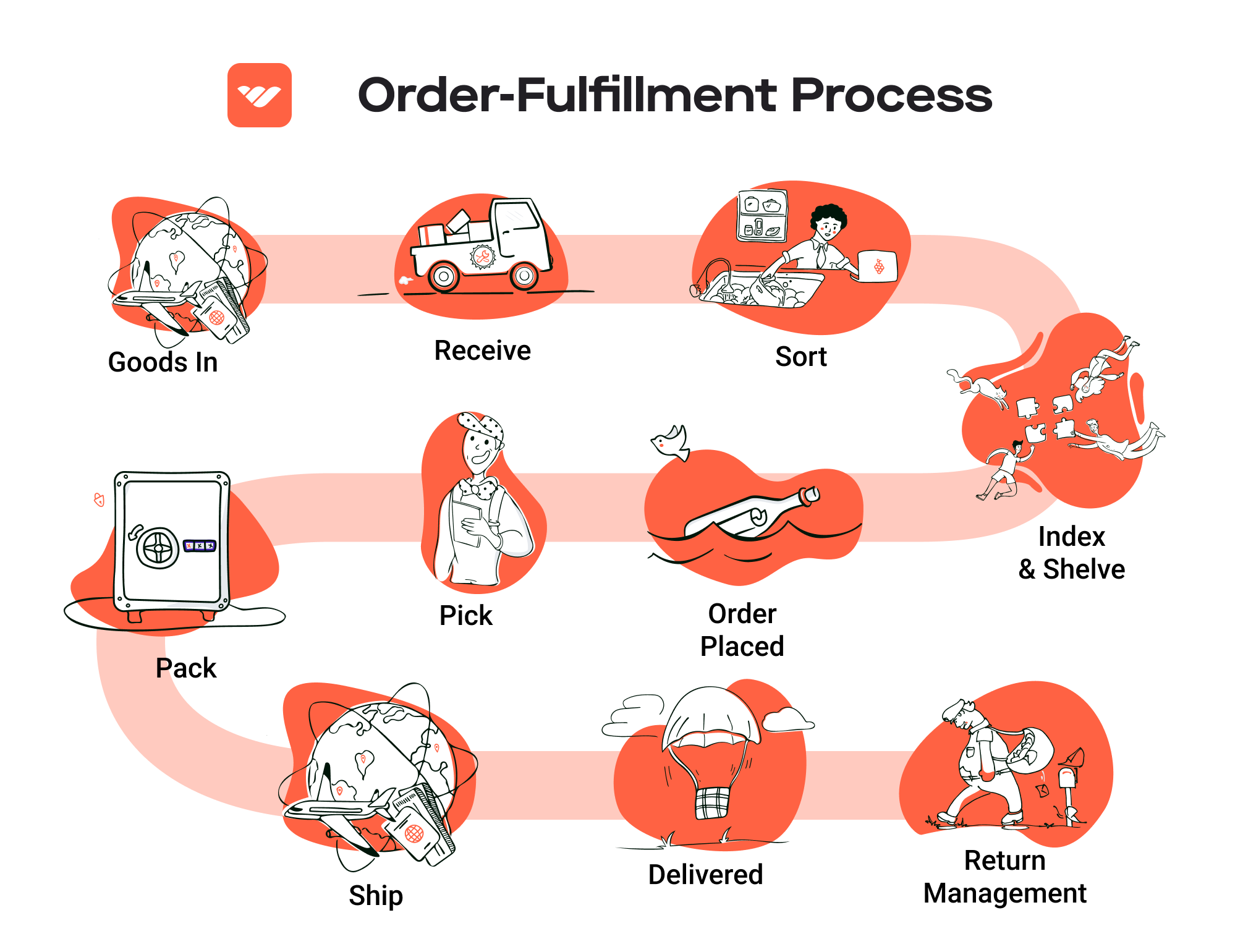
Comparing Fulfillment Models: In-House vs. 3PL vs. Dropshipping
Fulfillment Model Comparison
| Model | Who Handles Inventory | Best For (Business Stage) | Key Advantage | Key Disadvantage |
|---|---|---|---|---|
| In-House Fulfillment | The business itself | Established businesses | Full control over inventory and operations | High overhead costs and resource commitment |
| Third-Party Logistics (3PL) | A third-party provider | Growing businesses | Scalable operations and access to expertise | Less control over inventory and fulfillment process |
| Dropshipping | Supplier or manufacturer | Startups and small businesses | Low upfront investment and operational simplicity | Lower margins and reliance on suppliers for quality |
In-House Fulfillment
In-house fulfillment refers to a model where a business manages its own storage, inventory, and shipping processes. This model is often adopted by established businesses that have the resources and infrastructure to handle logistics internally. The primary advantage of in-house fulfillment is the level of control it offers. Businesses can oversee inventory management, quality control, and shipping processes, ensuring that customer expectations are met without compromise. This can be especially important for brands that prioritize customer experience and brand integrity. However, this model comes with significant disadvantages, including high overhead costs associated with warehousing, staffing, and maintaining logistics technology. Additionally, businesses may face scalability challenges, as increasing order volumes can strain existing resources and require substantial investment in additional infrastructure.
Third-Party Logistics (3PL)
Third-party logistics (3PL) providers offer outsourced logistics services to businesses, handling warehousing, inventory management, and shipping. This model is particularly beneficial for growing businesses that want to scale their operations without the burden of managing logistics internally. By partnering with a 3PL, businesses gain access to specialized expertise, advanced technology, and a flexible infrastructure that can adapt to changing demands. This scalability allows businesses to focus on core competencies like marketing and product development while leaving the complexities of logistics to the experts. However, one of the main drawbacks of using a 3PL is the reduced control over inventory and fulfillment processes. Businesses must rely on their 3PL partner to meet service levels and quality standards, which can lead to inconsistencies if communication and alignment are not effectively managed.
Dropshipping
Dropshipping is a fulfillment model where a business sells products it does not keep in stock. Instead, when a customer places an order, the business purchases the item from a third-party supplier who then ships it directly to the customer. This model is ideal for startups and small businesses that may not have the capital to invest in inventory upfront. The primary advantage of dropshipping is the low operational overhead; businesses can offer a wide range of products without the risk of unsold inventory. Additionally, dropshipping allows for a more straightforward entry into e-commerce, as businesses can quickly adapt their offerings based on market demand. However, the key disadvantage lies in lower profit margins and a dependence on suppliers for product quality and timely shipping. Businesses must be cautious about supplier reliability, as any delays or issues on the supplier’s end can directly impact customer satisfaction and brand reputation.
In conclusion, each fulfillment model presents unique advantages and challenges, making it crucial for e-commerce businesses to align their choice with their operational capabilities, growth stage, and customer expectations. Understanding these models allows business owners to make informed decisions that can enhance their logistics efficiency and support their overall growth strategy.
A Deep Dive into Amazon FBA: Pros, Cons, and Who It’s For
Understanding Fulfillment by Amazon (FBA)
Fulfillment by Amazon (FBA) is a service offered by Amazon that allows e-commerce businesses to store their products in Amazon’s fulfillment centers. Amazon takes care of storage, packaging, shipping, and customer service for these products, enabling sellers to focus on other aspects of their business. This service has gained popularity among online retailers, especially those looking to scale their operations quickly without the overhead of managing logistics.
How FBA Works
When a seller enrolls in FBA, they send their inventory to Amazon’s warehouses. Once the products are stored, Amazon handles all logistics, including:
- Storage: Products are stored in Amazon’s fulfillment centers until sold.
- Order Fulfillment: When a customer places an order, Amazon picks, packs, and ships the item directly to the customer.
- Customer Service: Amazon provides customer service for FBA orders, handling inquiries and returns.
- Returns Management: Amazon manages returns, making it easier for sellers to maintain customer satisfaction.
Using FBA allows sellers to leverage Amazon’s vast logistics network, ensuring timely delivery and access to millions of potential customers.
Pros of Using FBA
-
Prime Eligibility: One of the most significant advantages of FBA is that products become eligible for Amazon Prime. This means that Prime members can receive products with free two-day shipping, which can significantly increase sales.
-
Customer Trust: Amazon is a trusted platform for online shopping. By using FBA, sellers can benefit from Amazon’s reputation, providing customers with peace of mind regarding their purchases.
-
Multi-Channel Fulfillment: FBA is not limited to Amazon sales. Sellers can use FBA to fulfill orders from other channels, such as their own websites or eBay. This flexibility allows businesses to streamline their logistics operations.
-
Scalability: FBA enables sellers to scale their operations quickly. As demand increases, sellers can send more inventory to Amazon without needing to invest in additional warehousing or logistics infrastructure.
-
Time Savings: By outsourcing fulfillment, sellers can save time on packaging and shipping, allowing them to focus on marketing, product development, and customer engagement.
-
Access to Amazon’s Tools and Resources: FBA sellers gain access to Amazon’s extensive suite of tools and services, including advertising, analytics, and inventory management, which can help optimize their sales strategies.
Cons of Using FBA
-
High Fees: FBA comes with various fees, including storage fees and fulfillment fees. For sellers with low-margin products, these costs can eat significantly into profits.
-
Strict Inventory Rules: Amazon enforces strict inventory management policies. Sellers must comply with these rules, or they risk incurring penalties or having their accounts suspended.
-
Commingling Risks: FBA products may be commingled with inventory from other sellers. This means that sellers may not have control over which specific units are shipped to customers, potentially leading to issues with returns or brand reputation.
-
Limited Control Over Shipping: While Amazon handles shipping, sellers have less control over the packaging and branding of their products. This can dilute brand identity, especially for businesses that prioritize unique packaging.
-
Long-Term Storage Fees: If inventory remains unsold in Amazon’s warehouses for extended periods, sellers may incur long-term storage fees, further impacting profitability.
-
Dependency on Amazon: Relying heavily on FBA can create a dependency on Amazon’s platform. Changes in Amazon’s policies, fees, or algorithms can significantly affect a seller’s business.
Who is FBA Best For?
FBA is particularly suited for:
-
Small to Medium-Sized Businesses: Businesses that want to scale quickly without investing heavily in logistics infrastructure can benefit significantly from FBA.
-
E-commerce Entrepreneurs: Those looking to enter the e-commerce space with minimal upfront investment in warehousing and fulfillment will find FBA an attractive option.
-
Sellers with High Demand Products: If your products are popular and have a high turnover rate, the benefits of FBA, including Prime eligibility and quick shipping, can lead to increased sales.
-
Sellers with Limited Time: Entrepreneurs who may not have the time or resources to handle logistics can focus on growth and marketing while Amazon manages fulfillment.
-
Multi-Channel Sellers: Businesses that sell across multiple platforms can streamline their operations by using FBA for all order fulfillment.
In conclusion, Fulfillment by Amazon offers a robust solution for e-commerce businesses looking to streamline operations, gain customer trust, and scale rapidly. However, potential sellers should carefully weigh the pros and cons and consider their specific business needs before committing to the FBA model.
Core Services Offered by Fulfillment Centers
Inventory Management & Warehousing
Inventory management and warehousing form the backbone of any fulfillment center’s operations. This service involves the systematic tracking and storage of products to ensure that e-commerce businesses can efficiently manage stock levels, reduce excess inventory, and avoid stockouts. Fulfillment centers like Chewy employ sophisticated inventory management systems that utilize real-time data and analytics to monitor product availability, track sales trends, and forecast demand.
Benefits:
1. Optimized Stock Levels: By accurately managing inventory, businesses can maintain optimal stock levels, ensuring that they have enough products to meet customer demand without overstocking, which ties up capital.
2. Space Efficiency: Fulfillment centers are designed to maximize storage space, allowing businesses to store a larger variety of products without the need for additional warehouse space.
3. Reduced Costs: Effective inventory management minimizes storage costs and reduces the likelihood of markdowns on unsold inventory, improving overall profitability.
Pick and Pack Services
Pick and pack services are essential for preparing orders for shipment. This process involves selecting items from the warehouse shelves (picking) and packaging them appropriately for delivery (packing). Fulfillment centers utilize advanced technology, such as barcode scanning and automated picking systems, to streamline this process, ensuring that orders are fulfilled quickly and accurately.
Benefits:
1. Speed and Accuracy: Automation and trained personnel in fulfillment centers enhance the speed and accuracy of the picking and packing process, resulting in faster order fulfillment and increased customer satisfaction.
2. Scalability: As an e-commerce business grows, fulfillment centers can easily scale their pick and pack operations to accommodate increased order volumes without the need for significant capital investment in infrastructure.
3. Customization: Many fulfillment centers offer customizable packing options, including branded packaging, which helps businesses enhance their brand image and customer experience.
Kitting and Assembly
Kitting and assembly services involve grouping multiple products into a single package or assembling products before shipping. This service is particularly beneficial for businesses that sell products that are often used together, such as pet supplies that include food, toys, and grooming items. Fulfillment centers can handle the intricate process of combining these items efficiently, ensuring that they are ready for shipment as a complete unit.
Benefits:
1. Streamlined Processes: By offering kitting and assembly, fulfillment centers help businesses streamline their logistics operations, reducing the time and resources spent on assembling products in-house.
2. Enhanced Product Offering: Businesses can create bundled offerings that encourage customers to purchase multiple products at once, increasing average order value and enhancing customer satisfaction.
3. Quality Control: Fulfillment centers typically have quality control measures in place to ensure that assembled kits meet the required standards, reducing the likelihood of returns due to assembly errors.
Returns Management (Reverse Logistics)
Returns management, or reverse logistics, is the process of handling products that customers return after purchase. This service is critical for e-commerce businesses, as return rates can be significantly higher in online retail compared to brick-and-mortar stores. Fulfillment centers provide efficient returns processing services that include inspecting returned items, restocking, and managing defective products.
Benefits:
1. Customer Retention: Efficient returns management enhances customer satisfaction by making the return process simple and hassle-free, which can lead to repeat business.
2. Cost Reduction: By managing returns effectively, fulfillment centers can minimize the costs associated with processing returns, including shipping and restocking fees.
3. Data Insights: Analyzing return data can provide valuable insights into customer preferences and product issues, enabling businesses to make informed decisions about inventory and product offerings.
In summary, utilizing the core services offered by fulfillment centers enables e-commerce businesses to streamline their operations, enhance customer satisfaction, and ultimately scale their sales effectively. By outsourcing these critical logistics functions, business owners can focus on strategic growth and product development while ensuring that their fulfillment processes are in expert hands.
How to Choose a Fulfillment Partner: A 6-Point Checklist
Location & Warehouse Network
Importance: The geographical location of your fulfillment partner’s warehouses is crucial for optimizing shipping times and costs. A strategically placed partner can help you reach your customers faster, which is essential for maintaining a competitive edge in e-commerce.
Questions to Ask:
– Where are your fulfillment centers located, and how do they align with my target market?
– What is the average shipping time to my primary customer locations?
– Do you have multiple locations to accommodate regional variations in demand?
Technology & Integrations
Importance: In today’s fast-paced e-commerce environment, robust technology and seamless integrations with your existing systems (like your e-commerce platform, inventory management, and CRM systems) are non-negotiable. This capability ensures real-time data exchange, inventory tracking, and order management.
Questions to Ask:
– What technology platforms do you use for order management and tracking?
– Can your systems integrate with my current e-commerce platform and other software?
– Do you provide real-time visibility into inventory levels and order status?
Specializations (e.g., Cold Storage, Oversized Items)
Importance: Depending on your product offerings, you may require specialized services such as cold storage for perishables or handling oversized items. Ensuring your fulfillment partner has the necessary capabilities will prevent logistical challenges and customer dissatisfaction.
Questions to Ask:
– Do you have the facilities and expertise to handle specialized products, such as food items or large equipment?
– What measures do you have in place to ensure product safety and compliance with regulations?
– Can you accommodate seasonal fluctuations in demand for specialized items?
Scalability & Capacity
Importance: As your business grows, your fulfillment needs will evolve. A capable partner should be able to scale operations to meet increasing order volumes without compromising service quality.
Questions to Ask:
– How do you handle peak seasons or unexpected surges in demand?
– What is your current capacity, and how quickly can you scale up operations if needed?
– Are there any limitations on the types of products or volume you can handle?
Pricing and Contracts
Importance: Understanding the pricing structure and contract terms of your fulfillment partner is critical for maintaining healthy profit margins. Transparent pricing models help you avoid hidden fees and unexpected costs.
Questions to Ask:
– Can you provide a detailed breakdown of your pricing structure?
– Are there any additional fees for services such as storage, packing, or shipping?
– What are the terms of your contract, and is there flexibility for renegotiation as my business grows?
Customer Support & Reviews
Importance: Exceptional customer support is vital for resolving issues quickly and maintaining a positive relationship. Additionally, researching reviews and testimonials from other clients can provide insights into the partner’s reliability and service quality.
Questions to Ask:
– What level of customer support do you offer, and how can I reach you in case of issues?
– Can you provide references or case studies from current clients?
– How do you handle complaints or service failures, and what is your process for resolution?
Conclusion
Choosing the right fulfillment partner is a pivotal decision that can significantly impact your e-commerce business’s growth and customer satisfaction. By thoroughly evaluating potential partners through this checklist, you can ensure that you select a fulfillment provider that aligns with your operational needs and business goals. Prioritize partners who demonstrate flexibility, technological adeptness, and a customer-centric approach, as these qualities will support your business’s scalability and success in the competitive e-commerce landscape.
Understanding Fulfillment Pricing: A Breakdown of Common Fees
Initial Setup Fees
Initial setup fees are typically charged by fulfillment centers to cover the costs associated with onboarding a new client. This may include account setup, integration with your e-commerce platform, and the initial configuration of your inventory management system. The fee can vary significantly based on the complexity of your operations and the services offered by the fulfillment center.
To calculate this fee, consider the following factors:
– Complexity of Integration: If your e-commerce platform requires custom API integrations, expect higher costs.
– Volume of Products: More SKUs can lead to higher setup fees due to additional time required to input and organize inventory.
– Training Needs: If your team needs extensive training on the fulfillment system, this may also contribute to the initial setup costs.
Receiving Fees
Receiving fees are incurred when the fulfillment center accepts your inventory. This fee typically covers the labor and resources required to unload, inspect, and store your products.
Calculating receiving fees usually involves:
– Per Pallet or Per Item Charges: Fulfillment centers may charge a flat fee per pallet received or a fee based on the number of items processed.
– Inspection Requirements: If your products require quality checks or special handling, additional charges may apply.
– Volume Discounts: Some centers offer discounts based on the volume of inventory received, which can help reduce costs for businesses with large shipments.
Storage Fees (per pallet/bin)
Storage fees are charged for the space your inventory occupies within the fulfillment center. These fees can be structured either on a per pallet or per bin basis and are typically billed monthly.
Key components for calculating storage fees include:
– Space Utilization: The more space your products take up, the higher your storage fees will be. This can be calculated based on the dimensions of your pallets or bins.
– Duration of Storage: Fees may be tiered based on how long your products remain in storage, with longer durations potentially incurring higher rates.
– Seasonal Variations: During peak seasons, such as holidays, storage fees may increase due to higher demand for space.
Pick & Pack Fees (per item/order)
Pick and pack fees are charged for the labor involved in retrieving items from storage and packaging them for shipment. This fee is crucial for e-commerce businesses, as it directly affects order fulfillment efficiency.
To calculate pick and pack fees, consider:
– Per Item or Per Order Fee: Many fulfillment centers charge a standard fee for picking each item or a flat fee per order, regardless of the number of items.
– Complexity of Orders: If your orders require special packaging or kitting (e.g., bundling products together), expect to pay additional fees.
– Volume Discounts: Similar to receiving fees, businesses with higher order volumes may qualify for discounts, reducing overall costs.
Shipping Fees
Shipping fees cover the costs associated with transporting your products from the fulfillment center to the customer. These fees can vary widely based on several factors, including the shipping carrier used, the destination, and the shipping method selected.
Calculating shipping fees typically involves:
– Carrier Rates: Most fulfillment centers partner with multiple carriers (e.g., FedEx, UPS, USPS) and can provide a range of shipping options. Rates vary based on carrier agreements and can be affected by package weight, dimensions, and shipping speed.
– Dimensional Weight Pricing: For larger, lighter packages, shipping costs may be calculated based on dimensional weight rather than actual weight, potentially increasing fees.
– Zone-Based Pricing: Shipping fees may also vary based on the distance between the fulfillment center and the delivery location, often categorized into zones.
Tips for Getting an Accurate Quote
- Be Transparent: Provide detailed information about your product dimensions, weights, and volume to get a comprehensive quote.
- Ask for Itemized Pricing: Request a breakdown of all potential fees, including initial setup, receiving, storage, pick and pack, and shipping fees.
- Consider Seasonal Variations: Inquire about how fees may change during peak seasons and whether the fulfillment center offers any discounts for long-term contracts.
- Evaluate Service Levels: Determine if additional services, such as custom packaging or special handling, are necessary and how they will affect pricing.
- Compare Multiple Providers: Don’t settle for the first quote. Comparing offers from different fulfillment centers can help you find the best fit for your business needs and budget.
By understanding these common fulfillment pricing models and following these tips, e-commerce business owners can better navigate the costs associated with outsourcing their logistics, ultimately leading to improved efficiency and customer satisfaction.
Frequently Asked Questions (FAQs) about Fulfillment
1. What is the Chewy Fulfillment Center CLT1?
The Chewy Fulfillment Center CLT1 is one of Chewy’s strategic warehouses located in Charlotte, North Carolina. It is designed to streamline operations for e-commerce by efficiently managing inventory, order processing, and shipping, thereby ensuring prompt delivery of pet supplies to customers across the region.
2. How does Chewy’s fulfillment process work?
Chewy’s fulfillment process involves several key steps: receiving inventory, storing products in organized aisles, picking and packing orders once they are placed online, and shipping them out to customers. The process is optimized for speed and accuracy, utilizing technology and a dedicated team to ensure timely delivery.
3. What is the difference between a warehouse and a fulfillment center?
A warehouse primarily focuses on storing goods for long periods, while a fulfillment center is designed for the quick processing and shipping of orders. Fulfillment centers often include additional services such as inventory management, order tracking, and customer service, making them essential for e-commerce operations.
4. What is a 3PL (Third-Party Logistics)?
A 3PL is a company that provides outsourced logistics services to businesses, including warehousing, transportation, and distribution. By partnering with a 3PL, businesses can leverage their expertise and infrastructure to streamline their supply chain operations without the need for large capital investments.
5. How much do fulfillment services cost?
The cost of fulfillment services can vary widely based on factors such as order volume, storage space required, and specific services offered (e.g., packing, shipping, returns handling). Generally, costs can include storage fees, pick-and-pack fees, shipping costs, and additional service charges. It’s advisable to request quotes from multiple providers to compare options.
6. What are the benefits of using Chewy’s fulfillment services?
Using Chewy’s fulfillment services allows businesses to benefit from their extensive logistics network, fast shipping options, and expertise in pet product distribution. This can lead to improved customer satisfaction, reduced shipping times, and the ability to scale operations quickly without investing heavily in infrastructure.
7. How does Chewy ensure the accuracy of order fulfillment?
Chewy employs a combination of technology and trained personnel to ensure order accuracy. Automated systems track inventory levels, while scanning technology is used during the picking process to confirm the correct items are selected. Regular audits and quality checks further enhance accuracy.
8. Can I track my orders fulfilled by Chewy?
Yes, Chewy provides tracking information for all orders fulfilled through their centers. Customers receive an email confirmation with tracking details once their order has been shipped, allowing them to monitor the status of their delivery in real-time.
9. What types of products are stored in the Chewy Fulfillment Center CLT1?
The Chewy Fulfillment Center CLT1 stores a wide variety of pet products, including food, toys, medications, and grooming supplies. The center is equipped to handle diverse inventory to meet the needs of pet owners across the country.
10. How can I partner with Chewy for fulfillment services?
Businesses interested in partnering with Chewy for fulfillment services should reach out directly through Chewy’s corporate website or contact their business development team. They can provide specific information on partnership opportunities, requirements, and the application process.
Conclusion: Is Outsourcing Fulfillment the Right Move for Your Business?
Evaluating the Benefits of Outsourcing Fulfillment
Outsourcing fulfillment can be a transformative move for e-commerce businesses looking to streamline operations and enhance customer satisfaction. By leveraging a fulfillment partner, you can save valuable time that can be redirected toward strategic initiatives, such as marketing and product development. This allows you to focus on your core competencies while leaving the complexities of logistics to experts.
Scalability is another significant advantage of using a fulfillment service. As your business grows, so do your logistics demands. A proficient fulfillment partner can seamlessly adjust to your changing needs, ensuring that you can scale operations without the burden of investing in additional infrastructure or resources. This flexibility is crucial in today’s fast-paced e-commerce environment, where consumer demands can shift rapidly.
Additionally, partnering with a fulfillment center provides access to industry expertise. Established providers, such as Chewy, have refined their processes to ensure efficient inventory management, order accuracy, and timely deliveries. Their experience translates into improved operational performance, which can enhance your brand’s reputation and customer loyalty.
However, selecting the right fulfillment partner is paramount. Not all providers are created equal, and the wrong choice can lead to operational hiccups that may hinder your growth. It’s essential to evaluate potential partners based on their technology, service offerings, and alignment with your business goals.
To determine if outsourcing fulfillment is the right strategic move for your business, conduct a thorough audit of your current shipping process. Assess your operational challenges, costs, and customer feedback. This analysis will help you identify whether a fulfillment partner could enhance your logistics strategy and support your growth objectives. Taking this proactive step could be the key to unlocking your business’s full potential in the competitive e-commerce landscape.
Important Disclaimer
⚠️ Important Disclaimer
The information in this guide is for educational purposes. Fulfillment services, pricing, and platform features change frequently. Always conduct your own due diligence and consult with providers directly before making business decisions.
